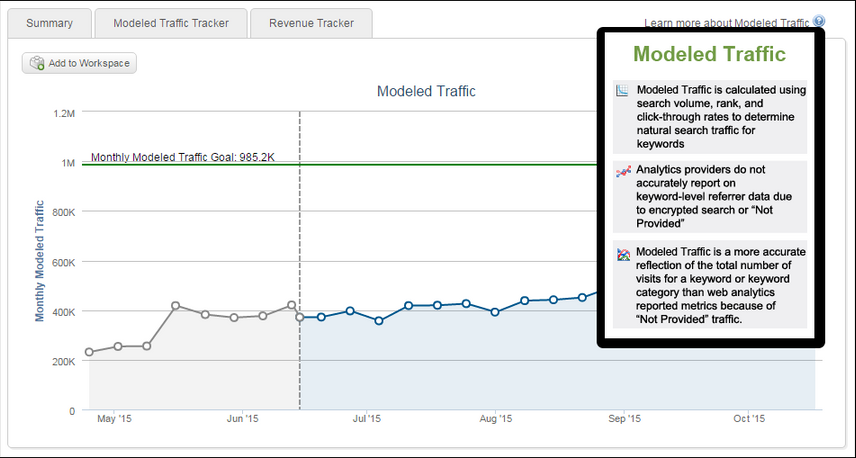More Specifics on Conductor’s Not Provided Solution, Modeled Traffic—Update
- Thought Leadership
- By Seth Besmertnik
- 5 minutes read
Struggling with technology that isn't showing you the traffic you're getting? Check out Conductor's Modeled Traffic, one of a few total traffic solutions.
Lots of interest in yesterday’s post on the launch of Modeled Traffic and I wanted to follow up with a bit more detail on the specific problems we’re trying to solve and how we go about doing it.
Two years ago, Google made an announcement that single digit % of keyword searches would start to disappear from analytics packages. From that moment on—organic search traffic has ceased to have precise data.
To understand how TrueTraffic works, let’s first run through the key problems we are trying to solve:
We No Longer Know Which Keywords are Being Used to Discover Our Content
This is probably the more concerning thing for marketers. For years Google has been telling us to just create great content that your visitors will love—but now they've tried to shut off a key piece of information that helps content strategists pick the right areas to invest in building great, informative content.
While we still know how much traffic a given piece of content is receiving from Google, we need to understand all the keywords used to find this piece of content in order to know which keywords are driving more traffic, and which ones are driving less traffic.
We No Longer Know How Much Traffic Each Keyword is Driving to Our Content
So even if you knew which keywords were being used to find a piece of content, you still don’t know which keywords are driving which portion of the total traffic to the page. Marketers are no longer able to report how different variations of keywords are driving traffic for different product lines or categories. Am I getting a lot of organic traffic from a large set of different keywords, or from a few really specific search terms – and what should I do about that? Is this page concentrated by traffic from one keyword or is it diversified across several keywords?
When Google had single digit variance it probably didn't matter from a practical standpoint. Marketers care more about useful numbers—think about the rough number of people in a TV or Radio media buy vs. knowing the EXACT number of people watched a specific ad. But with the recent updates, the numbers are all nearly zero (zero traffic) which is not helpful.
We Built Modeled Traffic as a Way to Help Marketers with Both of These Problems
Problem #1: Which Keywords are Being Used to Find My Content
We cannot completely solve this problem but we have several ways to bridge the gap and deliver a lot of value. These will include:
- We take the vast sets of keywords our customers already know are being used to find their sites and we discover if any of their existing pages show up in the Google results for them. This creates a relationship between those keywords and a page from your site.
- We have an enormous index of keywords that we track where we then “reverse” out your content against this index. For example, if in our index is the keyword “digital cameras”, we then identify if you have any content for this keyword here. Once again, we create a keyword to page relationship.
- We leverage partner indexes like SEMrush, and we do the same thing as the above—just with their index.
- And lastly, we leverage the keyword data from other major search engines, like Bing, and map those keywords to your content.
This then gives us a comprehensive set of keywords mapped to your content. And the more you tell the system, the more comprehensive this will be. Of course for very long-tail keywords, this process still leaves something to be desired (we’re working on that for future iterations).
That leaves us with the next problem…
Problem #2: How much traffic are these keywords driving to each piece of content?
We use the keyword to page relationships from above, and we then apply an algorithm to “estimate” the traffic for each keyword against the keyword. The makeup of this algorithm is as follows:
- Online visibility: This is basically your presence in the non-personalized SERPS or for us SEO people – your rank position;
- Consumer Demand: How often these terms are searched. While not always exact, they get you well into the range of useful metrics.
- Consumer Behavioral Models: This is where the Conductor’s product and engineering teams have done some great work, and continue to iterate on as we learn more. We use a variety of data, including specific historical analysis of clicks in the various visibility areas, the specific attributes of a keyword, and we look at the data that we are getting from the other engines about how consumers click to put together a model that projects the Modeled Traffic from the first two numbers.
Our customers now have the ability at a domain level to select from one of our pre-built Consumer Models (sometimes referred to as click through curves), or they can customize this based on their own unique insight. This is then applied to all the respective places where Modeled Traffic is represented.

We understand this is not as “complete” as how things were in 2011, however, we’re pretty excited to help our customers solve these two problems and it’s only going to get better and better.
We believe that marketers deserve to understand how people find their content, and that as an industry we’ll use this data to only make the web a better place. Better content. Better experiences for searches. And happy consumers who are finding what they want when they set out to look for something.
For those of you that are new to Conductor, we are a solution for larger marketing teams or smaller companies with very ambitious goals and resources. Our solutions are customized and all prospective customers are escorted through our product via live demos and direct interactions. And we’re excited to show this new capability off, as well as the vast amount of technology we released at C3 last week.







